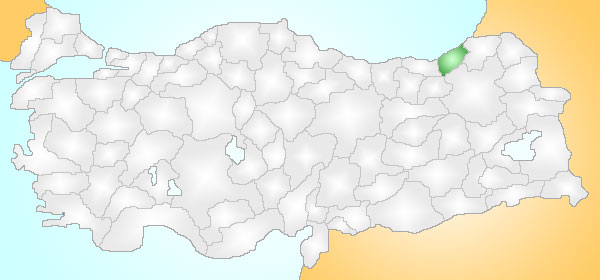- Fındıklı
Infobox Settlement
settlement_type = Town
subdivision_type = Country
subdivision_name = TUR
timezone=EET
utc_offset=+2
map_caption =Location of PAGENAME within Turkey.
timezone_DST=EEST
utc_offset_DST=+3official_name = Fındıklı
image_caption =
image_blank_emblem =
blank_emblem_type =
subdivision_type1=Region
subdivision_name1 = Black Sea
subdivision_type2=Province
subdivision_name2 = Rize| population_total = 16100|population_footnotes=
population_as_of =| 2000
population_density_km2 =
area_total_km2 = 409|elevation_m =
latd =
latm =
latNS = N
longd =
longm =
longEW = E
postal_code_type=Postal code
postal_code = 53
area_code = (0090)+ 464
leader_name =
blank_info = 53|blank_name=Licence plate
website =Fındıklı is a town and district of
Rize Province on theBlack Sea coast ofTurkey , east of the city ofRize .Etymology
The town was formerly known as "Vitze" which means "twig" or "branch" in the
Laz language and was renamed Fındıklı after the hazelnuts that were grown here, (although these have now mostly been replaced with tea).Geography
Like most
Black Sea districts Fındıklı consists of a small strip of coast and a larger area of hills and mountains behind (which lead up into theKaçkar Mountains. The recent widening of the Black Sea coast road has spoilt the quiet beauty of the seaside here, but the mountain countryside inland is still breathtakingly beautiful.There is little flat land in Fındıklı and most of the population lives in two large valleys, the "Çağlayan" ((Laz: "Abu") and the "Arılı" ("Pishala"). The climate is typical of the Black Sea coast, 6 months of dark cloud, 4 months overcast, six weeks of light cloud and 19 days of sunshine, with light rain at some point during every one of the 365 days of the year. These conditions are ideal for the crops that drive the local economy; tea, hazelnuts and some other fruits, 32,000 tons of tea each year and 750 tons of hazelnuts. Other produce includes milk, meat, eggs, honey and fish, and the new development is the planting of kiwi fruit.
Fındıklı itself is a small market town of 7,000 people. There is no industry and the young generations regularly migrate away to jobs in larger cities.
The people are mostly ethnic
Laz .History
See
Rize Province for the history the area, once part of theRoman Empire , and theEmpire of Trebizond , brought into theOttoman Empire in 1509 and briefly occupied byRussia at the end of theFirst World War .External links
* [http://www.findikli.gov.tr/ District governor's official website] tr icon
Wikimedia Foundation. 2010.
